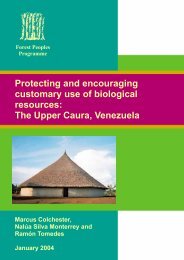Divers Paths to Justice - English - Forest Peoples Programme
Divers Paths to Justice - English - Forest Peoples Programme
Divers Paths to Justice - English - Forest Peoples Programme
You also want an ePaper? Increase the reach of your titles
YUMPU automatically turns print PDFs into web optimized ePapers that Google loves.
<strong>Divers</strong> <strong>Paths</strong> <strong>to</strong> <strong>Justice</strong>: Legal pluralism and the rights of indigenous peoples inSoutheast Asiadecision <strong>to</strong> precede the dispute resolution work by the conduct of a landsurvey, for the reasons mentioned above. 34 Thirdly, they disagree with theformat for providing information <strong>to</strong> the commission by the applicants andrespondents because they believe that it does not provide adequateopportunities for rights based upon oral cus<strong>to</strong>mary traditions, as opposed <strong>to</strong>rights based upon written title, and that it is therefore biased againstindigenous peoples. 35Simple system of litigation versus mainstream civil procedureQuite apart from the fact that litigants on land in the CHT have theopportunity of accessing the Land Commission (which is <strong>to</strong> provideexpeditious and cost-free redress, not involving legal practitioners), thesystem of administration of justice in the CHT is different from other partsof the country in some very crucial ways. Firstly, with regard <strong>to</strong> disputesbetween indigenous people, except for civil litigation involving commercialsuits and criminal offences of a serious nature, State courts are barred fromtrying these cases, which are triable by the Circle Chiefs and mauzaheadmen. 36 Secondly, with regard <strong>to</strong> civil litigation, the complex Code ofthe quorum for the commission, which would be complete even in the absence oftwo out of the three indigenous members of the concerned district or chief’s circle.Secondly, in the case of absence of consensus among its members, the decision ofthe chairperson is <strong>to</strong> be regarded as the decision of the entire commission.34 See, for example, the views expressed in writing by the three traditional chiefs ina memorandum <strong>to</strong> the Land Commission chairman; reported in The Prathom Alo,Dhaka, 15 July 2010.35 Based upon discussions with members of the CHT Commission (the writerhimself is one of its members), including J. B. Larma, chairperson, CHT RegionalCouncil, Raja Saching Prue Chowdhury, Mong Chief, and Chaw Hla PrueChowdhury, representative of Bohmong Chief, on several occasions in May-September 2010.36 Extracts from sections 8(3) and 8(4), CHT Regulation, 1900 (as amended in2003): “(3) The Rangamati, Khagrachari and Bandarban districts of the ChittagongHill Tracts shall constitute three separate civil jurisdictions under three DistrictJudges. (4) The Join District Judge as a court of original jurisdiction, shall try allcivil cases in accordance with the existing laws, cus<strong>to</strong>ms and usages of the districts117
















